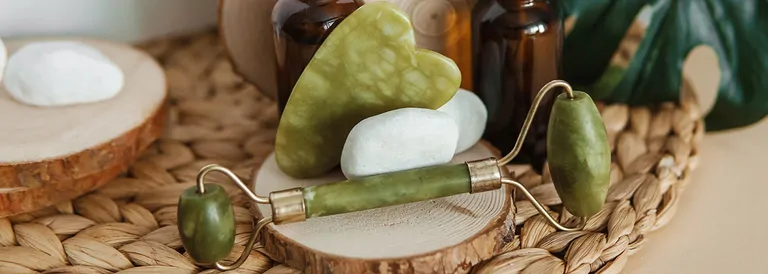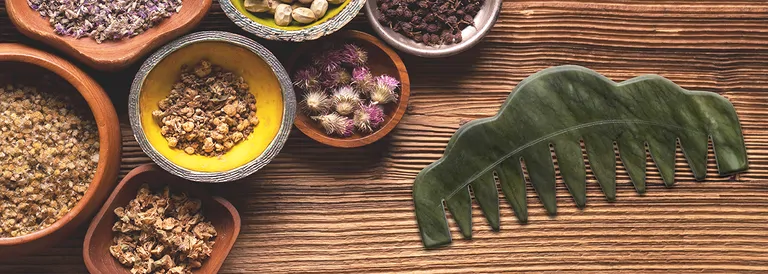Serpentine - Meaning, effort and application
Serpentine helps to make it easier for us to set boundaries and create enough space for ourselves. It balances out tension and mood swings and can shield us from negative external energies. Secure and at peace within ourselves, we can also provide help and support to our fellow human beings. During this time of introspection, the light green stone can be particularly useful for meditation.
Huge selection of Serpentine items at wholesale prices
Mineralogical profile of Serpentine
Formula: Mg6[(OH)8/Si4O10]
Category: phyllosilicate, serpentine series
Formation: metamorphic, occurs rock-forming in areas of crystalline slate, formed by the transformation of magnesium-rich silicates
Color: light colors from pale yellow-green to dark olive
Luster: resin, fat, silky luster, matt
Crystal system: depending on the Serpentine variety monoclinic (antigorite), rhombic (chrysotile), trigonal (lizardite)
Mohs hardness: 2.5 to 3
Cleavability, fracture: none; splintery, conchoidal fracture
Localities, main supplier countries: Worldwide deposits, important localities are in China and Afghanistan (precious serpentine / China jade), Tanzania (chytha) and Australia (silver eye). Amber in Austria is also known for precious Serpentine.
Appearance: Antigorite and lizardite form dense masses or flaky to scaly aggregates, chrysotile forms fine fibers.
Use: Serpentine is used in stonemasonry and arts and crafts. It has a millennia-old tradition in Europe as a "fright stone" (protective stone against terror). It is also still used in modern stone healing as a stone for protection, demarcation and inner peace. Astrology uses Serpentine to bring inner peace and mood balance to Libra, Aries and Scorpio natives.
Origin of the name Serpentine and varieties
The name "Serpentine" is derived from the medieval "serpentina", the origin of which is the Latin word "serpens" (snake). This name is presumably due to the similarity of the gemstone to the typical markings of snakes.
Serpentine refers to a whole group of different minerals, including amesite, antigorite (foliated serpentine), berthierine, brindleyite, chrysotile (fibrous serpentine), cronstedtite, fraipontite, guidottiite, caryopilite, kellyite, lizardite, népouite and pecorite. The best known is the antigorite known as precious Serpentine.
A mixture of antigorite and chrysotile is referred to as "Silver Eye Serpentine"
Transparent antigorite is called precious serpentine or "China jade". Antigorite with dark spots is called chyta, silver eye consists of dark lizardite with light chrysotile.
"Serpentine marble" is usually used for Connemara marble from Ireland; this is a mixture of calcite, dolomite and Serpentine. Due to its vivid grain, the material is often used for art objects.
The trade name "Spiderweb Serpentine" refers to a serpentine with a dark pattern on a light background, reminiscent of spider webs.
Tumbled Stones, Smooth Stones and more articles made from Serpentine
Serpentine and jade
"Jade" is a diverse and occasionally misused term for minerals. The name originally comes from the Spanish "piedra de ijada" ("loin stone") and is derived from the earlier popular belief that jade was suitable for treating kidney diseases.
today refers to various green stones, in ancient China it was a general term for "valuable stone". Thus, "jade" is not a mineral in the modern sense of the word, but a general term for many different stones. Today, the name "China jade" is used to describe a beautiful light green Serpentine.
Misleading names are candite or Canada jade for the Spinel variety pleonast, serpentine jade for antigorite and Canada jade for Sodalite.
Use of Serpentine in gemstone wellness
Due to its relaxing and protective energy, Serpentine is a popular stone for wellness applications with gemstones. The green gemstone is of great importance as a massage stone, for preparing Gemstone Water or as a Gemstone Comb and Yoni Egg.
In Gemstone Balance, Monika Grundmann's treatment concept, Serpentine is used for the areas of security and protection. Serpentine helps to protect against external influences. Your own center is found and stabilized - inner peace is achieved. Self-awareness is supported by the light green Serpentine so that life can be approached in a balanced way. Nervousness and stress can be reduced. Mood swings are balanced or can at least be better tolerated. Peaceful compromises with oneself or with others are possible. Improved self-awareness can be creatively implemented. "I am in my center!" is the motto of Serpentine in Gemstone Balance. Serpentine is accompanied by Agate and Nephrite in Monika Grundmann's applications.
Serpentine wellness products for resellers and users
Serpentine combs
Gemstone combs have been worn as jewelry in the hair in various ancient cultures or used to comb the hair to enhance well-being. By gently stroking the hair along the body's energy flow, the chi, the life energy, is awakened and distributed harmoniously throughout the body. The green Serpentine has a harmonizing effect on the entire energy system and conveys a sense of security. Applications with the Serpentine comb support the energetic protective shield that guides you safely through everyday life. The combs are also enchanting accessories in your handbag or bathroom.
Serpentine: historical use and gemstone museums
Pliny the Elder (ca. 23 - 79 AD) already reported that Serpentine was good against snake bites, as the mineral rendered poisons harmless. The use of Serpentine for making drinking vessels was also derived from this idea - if the drink in the cup was poisoned, the cup would shatter.
Since the mid-16th century, elements for interior furnishings have been made from the Serpentine quarried near Zöblitz in the Saxon Ore Mountains. Due to its grain, which is reminiscent of Marble, and its good polishability, slabs for coffered panels in wall cladding and turned elements in railings and balustrades are very popular. Serpentine was often decorated with gilded silver elements. For example, Zöblitz Serpentine can be found in the Green Vault, the Dresden Court Church and the Semper Opera House.
Visit the Serpentine Museum in Zöblitz
The Rock Museum in Amber has an extensive collection of arts and crafts made from Serpentine, including a vase consisting of 800 individual pieces, which was awarded a gold medal at the Paris World Exhibition in 1958.
Visit the rock museum in Austria





